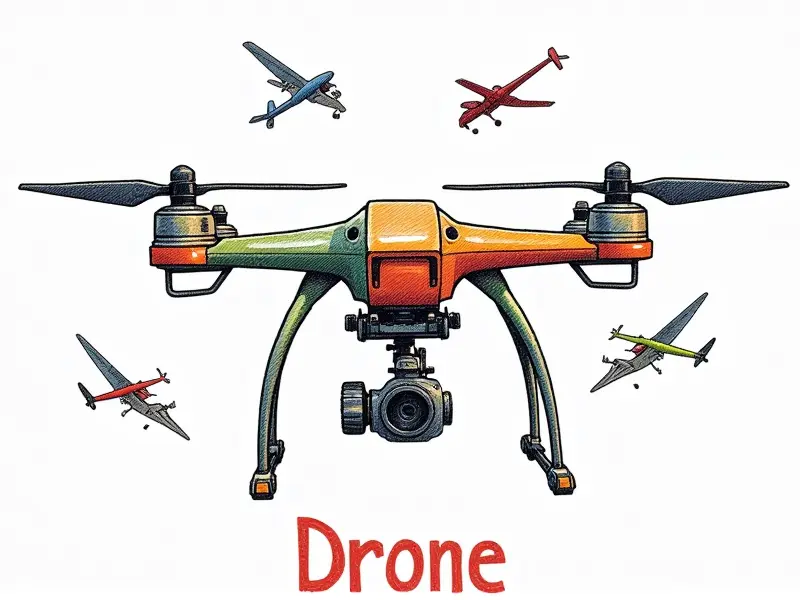How to calibrate drone camera?

Perfect Your Drone Camera Calibration
Calibrating your drone camera is essential for achieving the best possible footage and performance. Proper calibration ensures that your FPV, racing, or quadcopter drone captures high-quality images and videos with accurate settings. This guide will walk you through the steps to calibrate your drone camera effectively.
Quick Guide to Calibrating Drone Cameras
To start, it's crucial to understand why calibration is necessary. Calibration helps align the camera with the drone's orientation, ensuring that the footage matches what you see in real-time. Follow these steps for a quick and effective calibration:
- Check Your Drone’s Manual: Refer to your drone manufacturer's manual or online documentation for specific instructions.
- Install Required Software: Ensure that any necessary software, such as DJI GS Pro or similar applications, is installed and up-to-date.
- Connect Camera and Drone: Make sure your camera module is properly connected to the drone’s flight controller.
Mastering Drone Camera Setup in Minutes
Mastery of drone camera setup can significantly enhance your aerial photography and videography skills. Here are some tips for quick mastery:
- Understand Camera Settings: Familiarize yourself with ISO, shutter speed, aperture, and other critical settings.
- Use a Calibration Tool: Tools like the DJI Phantom 4 Pro’s built-in calibration feature can streamline the process.
- Practice Regularly: Frequent practice helps you become more adept at adjusting settings on-the-fly.
Easy Steps to Calibrate Your FPV Drone
FPV drones require precise camera calibration for optimal performance. Follow these easy steps:
- Align Camera and Goggles: Ensure that the camera’s view aligns perfectly with your goggles.
- Adjust Image Transmission Settings: Optimize settings such as frame rate, resolution, and latency for smooth video feed.
- Test in Flight: Fly your drone to test the alignment and make necessary adjustments.
Optimize Your Drone's Camera with Calibration
Calibration is key to optimizing your drone’s camera performance. Here are some strategies:
- Adjust White Balance: Fine-tune the white balance for accurate color representation.
- Battery Management: Ensure that battery levels do not affect image quality or transmission stability.
- Lighting Conditions: Adjust settings based on lighting conditions to avoid overexposure or underexposure.
Fast Track: Calibrate Your RC Quadcopter Cam
If you’re short on time, follow this fast track guide for calibrating your quadcopter camera:
- Initial Setup: Connect the camera to the flight controller and power up.
- Run Calibration Software: Use built-in software or third-party applications to run a calibration routine.
- Final Adjustments: Make any necessary manual adjustments based on test flights.
Simple Tips for Perfect Drone Camera Alignment
Perfect alignment is crucial for seamless FPV and racing experiences. Here are some simple tips:
- Use a Leveling Tool: Ensure the camera is perfectly level to avoid distortion.
- Check Lens Quality: Use high-quality lenses to minimize aberrations and improve clarity.
- Monitor Alignment During Flight: Continuously check alignment during flight for any deviations.
Instant Guide: Calibrate Your Racing Drone Cam
Racing drones demand precise calibration for competitive performance. Follow this instant guide:
- Pre-flight Checks: Verify that all connections are secure and the camera is properly mounted.
- Calibration Routine: Run a quick calibration routine to ensure optimal settings.
- Test in Flight: Fly your drone at high speeds to test stability and make necessary adjustments.
Quick Calibration Tricks for Better Drone Footage
These tricks can help you achieve better footage through quick calibration:
- Use a Calibration Chart: Place a chart in the drone’s field of view to check alignment and focus.
- Adjust Exposure Settings: Fine-tune exposure for different lighting conditions.
- Optimize Transmission Quality: Ensure that video transmission is clear and stable during flight.
Fine-Tuning Your Drone's Camera Settings
Fine-tuning your drone’s camera settings can significantly improve image quality. Here are some advanced tips:
- Adjust ISO Levels: Lower ISO for better clarity in low-light conditions.
- Battery Health Check: Regularly check battery health to maintain consistent performance.
- Update Firmware: Keep your drone’s firmware up-to-date for the latest features and bug fixes.
Maximize Image Quality Through Camera Calibration
To maximize image quality, thorough calibration is essential. Follow these steps to achieve optimal results:
- Initial Setup: Ensure all connections are secure and the camera is properly mounted.
- Run Comprehensive Calibration: Use a comprehensive calibration routine to cover all aspects of camera performance.
- Analyze Results: Review footage after each flight to identify areas for improvement.
Conclusion
Calibrating your drone’s camera is a critical step in achieving high-quality aerial photography and videography. By following the steps outlined above, you can ensure that your drone captures clear, stable, and accurate footage every time. Whether you’re flying an FPV drone or racing quadcopter, proper calibration will enhance your overall experience and performance.

